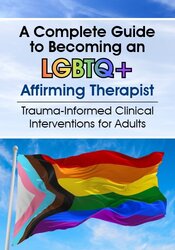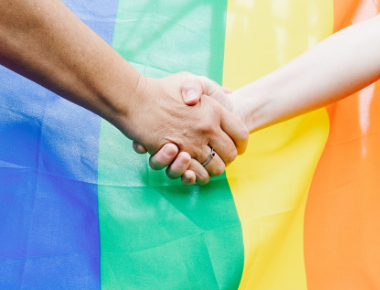Creating a Welcoming Space for LGBTQ+ Clients
12 Common Mistakes & 6 Affirming Practices

As a mental health professional it’s essential you do the work to avoid hurtful mistakes common when working with LGBTQ+ clients. Some of these include:
An LGBTQ-friendly practice is NOT the same as an LGBTQ-informed one—it’s time to close the gap.
Here are 12 common mistakes that clinicians make when working with LGBTQ+ clients, plus 6 simple affirming practices.
Common Therapist Mistakes That Break Trust
LGBTQ-Affirming Practices
1. Use the client’s language to define themselves and their practices.
2. Know and use the most up-to-date terminology.
3. Have LGBTQ literature and imagery in your waiting area and office.
4. Include queer- and trans-inclusive language in your paperwork and intake forms.
5. Know local LGBTQ resources and be prepared to offer those to clients.
6. Be an active ally in helping and validating clients.
- Not using the appropriate pronoun that best fits your client...
- Bringing your own biases about sexual orientation and gender to work, even when you don’t realize it...
- Or feeling so afraid of offending your client that you end up saying nothing at all.
An LGBTQ-friendly practice is NOT the same as an LGBTQ-informed one—it’s time to close the gap.
Here are 12 common mistakes that clinicians make when working with LGBTQ+ clients, plus 6 simple affirming practices.
Common Therapist Mistakes That Break Trust
- 1. Being neutral about microaggressions and systemic injustice.
2. Using heteronormative language in the intake paperwork and interview.
3. Using outdated terminology.
4. Failing to use proper pronouns/misgendering, especially when done repeatedly.
5. Not understanding basic ideas about sex and gender.
6. Having an “all relationships are the same” approach.
7. Being overly apologetic or defensive after making a mistake with terminology or pronouns.
8. Being evasive about sex and gender when the client wants to talk about it.
9. Asking invasive questions about the client’s sex life, body, or gender transition that are not clinically relevant.
10. Being unaware of one’s own homophobia, transphobia, or heterosexism, and/or denying it.
11. Not being up to date on current events that affect LGBTQ people.
12. Pushing clients to take coming out or transition steps they are not ready for.
LGBTQ-Affirming Practices
1. Use the client’s language to define themselves and their practices.
- Sexuality and gender cannot be neatly categorized in a binary way; rather, they exist on a spectrum of possibilities. A client may feel neither completely feminine or masculine; ask them where they see themselves on a spectrum, rather than forcing them to choose one or the other.
Be aware that the LGBTQ+ community includes more groups of people than the acronym lists. These include sexual identities like aromantic, demisexual, and sexually fluid, as well as gender identities like agender, bigender, and non-binary. It’s not necessary for you as a clinician to memorize all these terms, but in the spirit of being inclusive, be aware that there are other ways of identifying than lesbian, gay, bisexual, transgender, and queer.
If you’re ever unsure, ask a client what words they prefer to use. The more open we are about gender and sexuality, the more effective we will be in working with the LGBTQ community.
2. Know and use the most up-to-date terminology.
- Increasingly, the LGBTQ+ community is non-binary and inclusive. Many individuals feel more comfortable using the catch-all term “queer” rather than putting a specific label to their sexual orientation or gender identity. Despite past negative connotations, know that queer is an acceptable term to use.
Use gender-affirming language, and avoid outdated, potentially offensive terms. For example, instead of terms like “transsexual” or “transvestite,” use “trans” or “transgender.” An easy way to be more inclusive is to swap the phrase “both men and women” for “people of all genders.”
3. Have LGBTQ literature and imagery in your waiting area and office.
- Having LGBTQ literature and imagery in your office space immediately signals to your client that they’re in a safe environment. Additionally, have gender neutral bathrooms. If this is not possible, acknowledge this to your trans and nonbinary clients.
Additionally, be aware of how you greet clients and de-gender greeting language. Avoid using gendered terms of address such as “ma’am” or “sir.”
4. Include queer- and trans-inclusive language in your paperwork and intake forms.
- On any paperwork, leave the sexual orientation and gender options blank where possible. Let the client define their sexual orientation and gender, rather than limiting what they can choose. If you must provide a predefined list of options, be as inclusive as possible.
Know that the use of the correct pronouns is a recognition and a validation of who a person is. Be aware of, and don’t assume, anyone’s pronouns. Consider including your own pronouns on your website, business cards, marketing materials, and e-mail signature.
5. Know local LGBTQ resources and be prepared to offer those to clients.
- It can be useful to have a list of legal, medical, and social institutions that are supportive and competent. Especially if you work in a smaller city or town, don’t be afraid to reach out to these resources and establish their level of LGBTQ competency before referring clients. This is especially important when referring high risk clients to outpatient settings or hospitals.
6. Be an active ally in helping and validating clients.
- Our LGBTQ clients often deal with frequent or constant experiences of invalidation in the world. It’s important to be mindful of this and to avoid neutrality when clients bring it up. In other words, be an ally and side with the client.
Access the Complete Guide to Becoming an LGBTQ+ Affirming Therapist

This self-study course joins FIVE seminal experts in the LGBTQ+ field. Get step-by-step video modules, intake and assessment materials, and pertinent case studies that will help you develop individualized, turnkey treatment approaches for every step of your client’s unique self-discovery process. You’ll walk away with clear strategies to comfortably engage clients around cultural norms, gender, sex, relationships, and terminology.
Meet the Expert:
Aaron Testard, LMFT, LPCC, is a psychotherapist in private practice in Berkeley, California with nearly 20 years of experience. For 7 years, he served as Director of Clinical Programs at the Pacific Center for Human Growth, an LGBTQ counseling and support center where he designed and implemented psychotherapy services for individuals, couples, and families, 24 adult peer support groups, and an after-school youth program. He also has trained and supervised numerous interns over the years and has been an LGBTQ community mental health consultant for local clinics and organizations. Aaron has spent the majority of his career as an LGBTQ specialist, including time as an addiction counselor, a high school counselor, and a consultant for a felon re-entry program. In his current practice, he focuses on sexual and gender identity, working with adults, adolescents, and couples.
Aaron received his MA in Counseling Psychology from the California Institute of Integral Studies. He is a trained drama therapist, sensorimotor therapist, and practitioner of the Gottman couple’s method, EMDR, and DBT-informed client work.
Learn more about their educational products, including upcoming live seminars, by clicking here.
Aaron received his MA in Counseling Psychology from the California Institute of Integral Studies. He is a trained drama therapist, sensorimotor therapist, and practitioner of the Gottman couple’s method, EMDR, and DBT-informed client work.
Learn more about their educational products, including upcoming live seminars, by clicking here.



